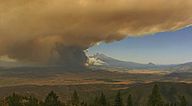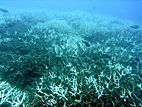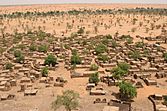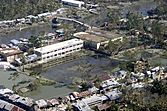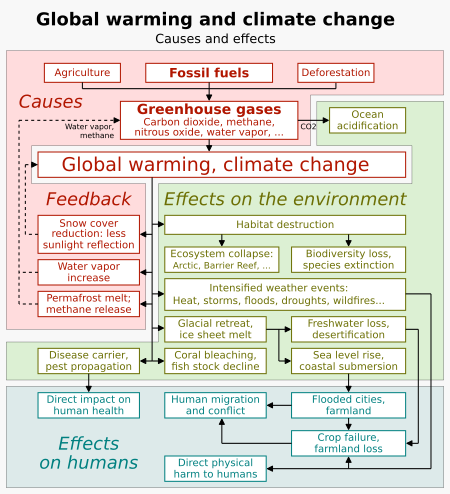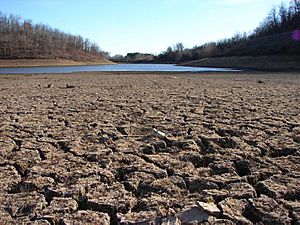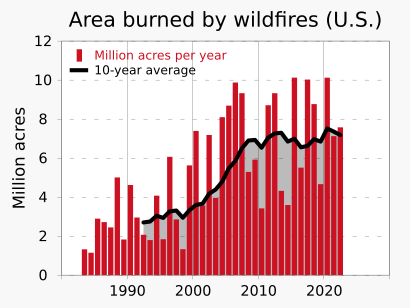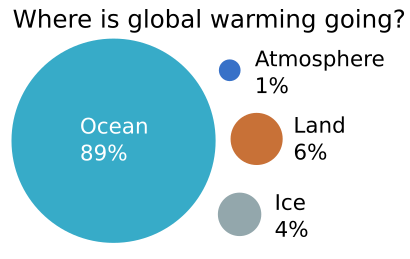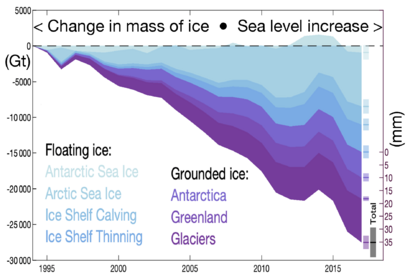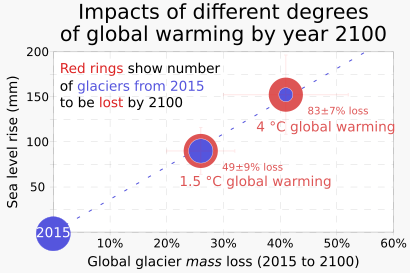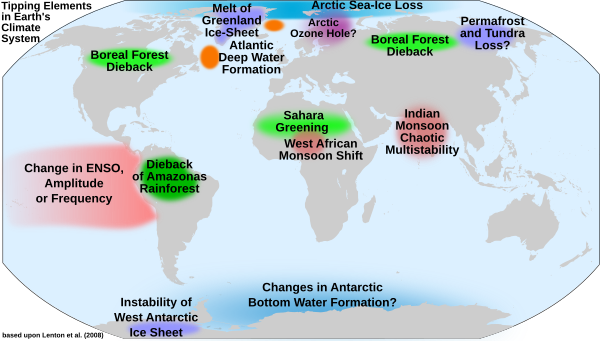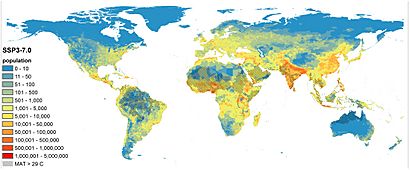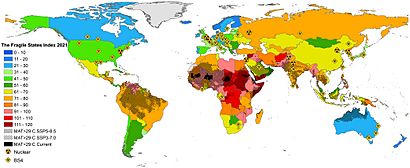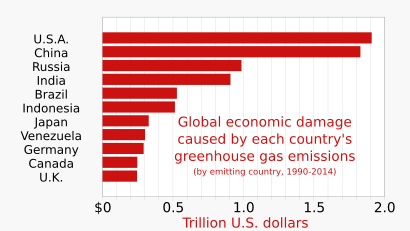Effects of climate change facts for kids
Climate change affects the physical environment, ecosystems and human societies. Changes in the climate system include an overall warming trend, more extreme weather and rising sea levels. These in turn impact nature and wildlife, as well as human settlements and societies. The effects of human-caused climate change are broad and far-reaching, especially if significant climate action is not taken. The projected and observed negative impacts of climate change are sometimes referred to as the climate crisis.
The changes in climate are not uniform across the Earth. In particular, most land areas have warmed faster than most ocean areas, and the Arctic is warming faster than most other regions. Among the effects of climate change on oceans are an increase of ocean temperatures, a rise in sea level from ocean warming and ice sheet melting, increased ocean stratification, and changes to ocean currents including a weakening of the Atlantic meridional overturning circulation. Carbon dioxide from the atmosphere is acidifiying the ocean.
Recent warming has strongly affected natural biological systems. It has degraded land by raising temperatures, drying soils and increasing wildfire risk. Species worldwide are migrating poleward to colder areas. On land, many species move to higher ground, whereas marine species seek colder water at greater depths. At 2 °C (3.6 °F) of warming, around 10% of species on land would become critically endangered.
Food security and access to fresh water are at risk due to rising temperatures. Climate change has profound impacts on human health, directly via heat stress and indirectly via the spread of infectious diseases. The vulnerability and exposure of humans to climate change varies by economic sector and by country. Wealthy industrialised countries, which have emitted the most CO2, have more resources and so are the least vulnerable to global warming. Economic sectors affected include agriculture, fisheries, forestry, energy, insurance, and tourism. Some groups may be particularly at risk from climate change, such as the poor, women, children and indigenous peoples. Climate change can lead to displacement and changes in migration flows.
Changes in temperature
Global warming affects all elements of Earth's climate system. Global surface temperatures have risen by 1.1 °C (2.0 °F) and are expected to rise further in the future. The changes in climate are not uniform across the Earth. In particular, most land areas have warmed faster than most ocean areas, and the Arctic is warming faster than most other regions. In addition, night-time temperatures have increased faster than daytime temperatures. The impact on the environment, wildlife, society and humanity depends on how much more the Earth warms.
One of the methods scientists use to predict the effects of human-caused climate change is to investigate past natural changes in climate. To assess changes in Earth's past climate scientists have studied tree rings, ice cores, corals, and ocean and lake sediments. These show that recent temperatures have surpassed anything in the last 2,000 years. By the end of the 21st century, temperatures may increase to a level not experienced since the mid-Pliocene, around 3 million years ago. At that time, mean global temperatures were about 2–4 °C (3.6–7.2 °F) warmer than pre-industrial temperatures, and the global mean sea level was up to 25 meters higher than it is today. The modern observed rise in temperature and CO2 concentrations has been so rapid that even abrupt geophysical events in Earth's history do not approach current rates.
How much the world warms depends on human greenhouse gas emissions and how sensitive the climate is to greenhouse gases. The more carbon dioxide (CO2) emitted in the 21st century the hotter the world will be by 2100. For a doubling of greenhouse gas concentrations, the global mean temperature would rise by about 2.5–4 °C (4.5–7.2 °F). If emissions of CO2 were to be abruptly stopped and no negative emission technologies deployed, the Earth's climate would not start moving back to its pre-industrial state. Instead, temperatures would stay elevated at the same level for several centuries. After about a thousand years, 20% to 30% of human-emitted CO2 would remain in the atmosphere, not taken up by the ocean or the land, committing the climate to a warmer state long after emissions have stopped.
Mitigation policies currently in place will result in about 2.7 °C (2.0–3.6 °C) warming above pre-industrial levels by 2100. If all unconditional pledges and targets made by governments are achieved, the temperature will rise by around 2.4 °C (4.3 °F). If additionally all the countries that have set or are considering setting net-zero targets achieve them, the temperature will rise by around 1.8 °C (3.2 °F). There is a substantial gap between national plans and commitments and actions so far taken by governments around the world.
Weather
The lower and middle atmosphere, where nearly all of the weather occurs, are heating due to the enhanced greenhouse effect. As temperatures increase, so does evaporation and atmospheric moisture content. As water vapour is also a greenhouse gas, this process acts as a self-reinforcing feedback.
The excess water vapour also gets caught up in storms and makes them more intense, larger, and potentially longer-lasting. This in turn causes rain and snow events to become stronger and leads to increased risk of flooding. Extra drying worsens natural dry spells and droughts, and increases risk of heat waves and wildfires. With recent climate trends clearly identified as caused by human activities, extreme event attribution estimates the impact of climate change on extreme weather events. For instance, such research can demonstrate that a specific heatwave was more intense due to climate change based on historical data for that region.
Heat waves and temperature extremes
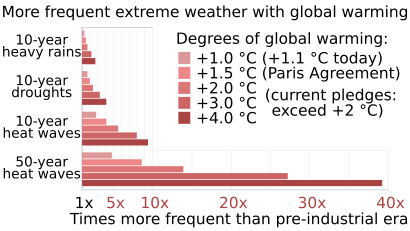
Heatwaves over land have become more frequent and more intense in almost all world regions since the 1950s, due to climate change. Furthermore, heat waves are more likely to occur simultaneously with droughts. Marine heatwaves are twice as likely as they were in 1980. Climate change will lead to more very hot days and fewer very cold days. There are fewer cold waves.
The intensity of individual heat waves can often be attributed to global warming. Some extreme events would have been nearly impossible without human influence on the climate system. A heatwave that would occur once every ten years before global warming started, now occurs 2.8 times as often. Under further warming, heatwaves are set to become more frequent. An event that would occur each ten year, would occur every other year if global warming reaches 2 °C (3.6 °F).
Heat stress is not only related to temperature, but also increases if humidity is higher. The wet-bulb temperature measures both temperature and humidity. Above a wet-bulb temperature of 35 °C (95 °F), this heat stress is beyond human adaptation, and can kill people. If global warming is kept below 1.5 or 2 °C (2.7 or 3.6 °F), this deadly heat and humidity can likely be avoided in most of the tropics, but there may still be negative health impacts.
There is some evidence climate change leads to a weakening of the polar vortex, which would make the jet stream more wavy. This would lead to outbursts of very cold winter weather across parts of Eurasia and North America, as well as very warm air incursions into the Arctic.
Rain
Warming increases global average precipitation (such as rain and snow). Higher temperatures lead to increased evaporation and surface drying. As the air warms it can hold more water - 7% more water vapour for every degree Celsius. Changes have already been observed in the amount, intensity, frequency, and type of precipitation. Overall, climate change is causing longer hot dry spells, broken by more intense heavy rainfall.
Climate change has increased contrasts in rainfall amounts between wet and dry seasons: wet seasons are getting wetter and dry seasons are getting drier. In the northern high latitutes, warming has also caused an increase in the amount of snow and rain. In the Southern Hemisphere, the rain associated with the storm tracks has shifted south. Changes in monsoons vary a lot: more monsoon systems are becoming wetter than drier. In Asia summer monsoons are getting wetter, whereas the West African monsoon is getting wetter over the central Sahel, and drier in the far western Sahel.
Extreme storms
Storms, including tropical cyclones and extratropical cyclones, become wetter under climate change. Both the maximum and mean rainfall rates increase. This more extreme rainfall is also true for thunderstorms in some regions. Furthermore, tropical cyclones and the storm tracks are moving poleward, so that some regions will see large changes in maximum wind speeds. There will likely be fewer tropical cyclones, but their strength is expected to increase. There has likely also been an increase in the number of tropical cyclones undergoing rapid intensification.
Impacts on land
Floods
Due to an increase in heavy rainfall events, floods are expected to become more severe when they do occur. However, the interactions between rainfall and flooding are complex. There are some regions in which flooding is expected to become rarer. This depends on several factors, such as changes in rain and snowmelt, but also soil moisture. For instance, climate change leaves soils drier in some areas, so they may absorb rainfall more quickly, leading to less flooding. However, dry soils can also become harder, causing heavy rainfall to runoff into rivers and lakes, which increases risks of flooding.
Droughts
Climate change affects multiple factors associated with droughts, such as how much rain falls and how fast the rain evaporates again. Warming over land increases the severity and frequency of droughts around much of the world. In some tropical and subtropical regions of the world, there will likely be less rain due to global warming, making them more prone to drought. These regions where droughts are set to worsen are Central America, the Amazon and south-western South America, West and Southern Africa, as well as the Mediterranean and south-western Australia.
Higher temperatures lead to increased evaporation, thus drying the soil and increasing plant stress, which will have impacts on agriculture. For this reason, even regions where overall rainfall is expected to remain relatively stable, such as central and northern Europe, will experience these impacts. Without climate change mitigation, it is expected that around a third of land areas will experience moderate or more severe drought by 2100. Due to global warming droughts are more frequent and intense than in the past.
Their impacts are made worse because of increased water demand, population growth and urban expansion in many areas. Land restoration, especially by agroforestry, can help reduce the impact of droughts.
Wildfires
Climate change promotes the type of weather that makes wildfires more likely. In some areas, an increase of wildfires has been attributed directly to climate change. Evidence from Earth's past also shows more fire in warmer periods. Climate change increases evaporation, which can cause vegetation to dry out. When a fire starts in an area with very dry vegetation, it can spread rapidly. Higher temperatures can also lengthen the fire season, the time of year in which severe wildfires are most likely, particularly in regions where snow is disappearing.
Even though weather conditions are raising the risks of wildfires, the total area burnt by wildfires has decreased. This is mostly because savanna has been converted to cropland, so there are fewer trees to burn. Prescribed burning, an indigenous practice in the US and Australia, can reduce wildfire burning. The carbon released from wildfires can further increase greenhouse gas concentrations. This feedback is not yet fully integrated into climate models.
Oceans
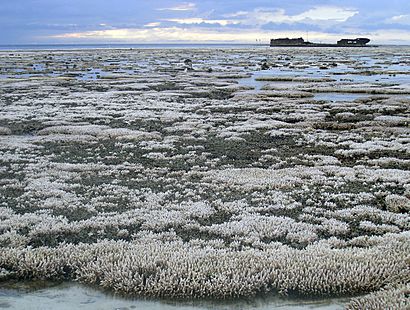
There are many effects of climate change on oceans. One of the main ones is an increase in ocean temperatures. More frequent marine heatwaves are linked to this. The rising temperature contributes to a rise in sea levels. Other effects include ocean acidification, sea ice decline, increased ocean stratification and reductions in oxygen levels. Changes to ocean currents including a weakening of the Atlantic meridional overturning circulation are another important effect. All these changes have knock-on effects which disturb marine ecosystems. The main cause of these changes is climate change due to human emissions of greenhouse gases. Carbon dioxide and methane are examples of greenhouse gases. This leads to ocean warming, because the ocean takes up most of the additional heat in the climate system. The ocean absorbs some of the extra carbon dioxide in the atmosphere. This causes the pH value of the ocean to drop. Scientists estimate that the ocean absorbs about 25% of all human-caused CO2 emissions.
Ocean temperature stratification is the difference in temperature between the various layers of the ocean. It increases as the ocean surface warms due to rising air temperatures. The decline in mixing of the ocean layers stabilizes warm water near the surface. It also reduces cold, deep water circulation. The reduced vertical mixing makes it harder for the ocean to absorb heat. So a larger share of future warming goes into the atmosphere and land. One result is an increase in the amount of energy available for tropical cyclones and other storms. Another result is a decrease in nutrients for fish in the upper ocean layers. These changes also reduce the ocean's capacity to store carbon. At the same time, contrasts in salinity are increasing. Salty areas are becoming saltier and fresher areas less salty.
Warmer water cannot contain the same amount of oxygen as cold water. As a result, oxygen from the oceans moves to the atmosphere. Increased thermal stratification may reduce the supply of oxygen from surface waters to deeper waters. This lowers the water's oxygen content even more. The ocean has already lost oxygen throughout its water column. Oxygen minimum zones are expanding worldwide.Sea level rise
Between 1901 and 2018, the average sea level rise was 15–25 cm (5.9–9.8 in), with an increase of 2.3 mm (0.091 in) per year since the 1970s. This is faster than the sea level had ever risen over at least the past 3,000 years. The rate accelerated to 4.62 mm (0.182 in)/yr for the decade 2013–2022. Climate change due to human activities is the main cause. Between 1993 and 2018, melting ice sheets and glaciers accounted for 44% of sea level rise, with another 42% resulting from thermal expansion of water.
Sea level rise lags behind changes in the Earth's temperature by many decades, and sea level rise will therefore continue to accelerate between now and 2050 in response to warming that has already happened. What happens after that depends on human greenhouse gas emissions. If there are very deep cuts in emissions, sea level rise would slow between 2050 and 2100. It could then reach slightly over 30 cm (0.98 ft) from now by 2100. With high emissions it would instead accelerate. It could rise by 1.01 m (3.3 ft) or even 1.6 m (5.2 ft) by then. In the long run, sea level rise would amount to 2–3 m (7–10 ft) over the next 2000 years if warming stays to 1.5 °C (2.7 °F). It would be 19–22 metres (62–72 ft) if warming peaks at 5 °C (9.0 °F).Ice and snow
The cryosphere, the area of the Earth covered by snow or ice, is extremely sensitive to changes in global climate. There has been an extensive loss of snow on land since 1981. Some of the largest declines have been observed in the spring. During the 21st century, snow cover is projected to continue its retreat in almost all regions.
Glaciers and ice sheets decline
Since the beginning of the twentieth century, there has been a widespread retreat of glaciers. Those glaciers that are not associated with the polar ice sheets lost around 8% of their mass between 1971 and 2019. In the Andes in South America and in the Himalayas in Asia, the retreat of glaciers could impact water supply. The melting of those glaciers could also cause landslides or glacial lake outburst floods.
The melting of the Greenland and West Antarctic ice sheets will continue to contribute to sea level rise over long time-scales. The Greenland ice sheet loss is mainly driven by melt from the top, whereas Antarctic ice loss is driven by warm ocean water melting the outlet glaciers.
Future melt of the West Antarctic ice sheet is potentially abrupt under a high emission scenario, as a consequence of a partial collapse. Part of the ice sheet is grounded on bedrock below sea level, making it possibly vulnerable to the self-enhancing process of marine ice sheet instability. A further hypothesis is that marine ice cliff instability would also contribute to a partial collapse, but limited evidence is available for its importance. A partial collapse of the ice sheet would lead to rapid sea level rise and a local decrease in ocean salinity. It would be irreversible on a timescale between decades and millennia. The complete loss of the West Antarctic ice sheet would cause over 5 metres (16 ft) of sea level rise.
In contrast to the West Antarctic ice sheet, melt of the Greenland ice sheet is projected to be taking place more gradually over millennia. Sustained warming between 1 °C (1.8 °F) (low confidence) and 4 °C (7.2 °F) (medium confidence) would lead to a complete loss of the ice sheet, contributing 7 m (23 ft) to sea levels globally. The ice loss could become irreversible due to a further self-enhancing feedback: the elevation-surface mass balance feedback. When ice melts on top of the ice sheet, the elevation drops. As air temperature is higher at lower altitude, this promotes further melt.
Sea ice decline
Sea ice reflects 50% to 70% of the incoming solar radiation back into space, while only 6% of the incoming solar energy is reflected by the ocean. As the climate warms, the area covered by snow or sea ice decreases. After sea ice melts, more energy is absorbed by the ocean, thus warming it. This ice-albedo feedback is a self-reinforcing feedback of climate change. Large-scale measurements of sea ice have only been possible since the satellite era.
Sea ice in the Arctic has declined in recent decades in area and volume due to climate change. It has been melting more in summer than it refreezes in winter. The decline of sea ice in the Arctic has been accelerating during the early twenty-first century, with a decline rate of 4.7% per decade (it has declined over 50% since the first satellite records). While ice-free summers are expected to be rare at 1.5 °C (2.7 °F) degrees of warming, they are set to occur at least once every decade at a warming level of 2 °C (3.6 °F). The Arctic will likely become ice-free at the end of some summers before 2050.
Sea ice extent in Antarctica varies a lot year by year. This makes it difficult to determine a trend, and record highs and record lows have been observed between 2013 and 2023. The general trend since 1979, the start of the satellite measurements, has been roughly flat. Between 2015 and 2023, there has been a decline in sea ice, but due to the high variability, this does not correspond to a significant trend.
Permafrost thawing
Globally, permafrost warmed by about 0.3 °C between 2007 and 2016. Permafrost extent has been diminishing for decades, and more decline is expected in the future. Permafrost thaw makes the ground weaker and unstable. In areas with much permafrost, nearby human infrastructure such as railways, settlements and pipelines may be damaged severely by the thaw. Furthermore, thawing soil can release methane and CO2 from microbial decomposition. This can generate a strong feedback loop to global warming. It is believed that carbon storage in permafrost globally is approximately 1600 gigatons, twice the atmospheric pool.
Wildlife and nature
Recent warming has strongly affected natural biological systems. Species worldwide are moving poleward to colder areas. On land, species may move to higher elevations, whereas marine species find colder water at greater depths. Of the drivers with the biggest global impact on nature, climate change ranks third over the five decades before 2020, with only change in land use and sea use, and direct exploitation of organisms having a greater impact.The impacts of climate change in nature are projected to become more pronounced in the next few decades. The stresses caused by climate change, added to other stresses on ecological systems (e.g. land conversion, land degradation, harvesting, and pollution), threaten substantial damage to or complete loss of some unique ecosystems, and extinction of species. Key interactions between species within ecosystems are often disrupted because species from one location do not leave the warming habitat at the same rate, giving rise to rapid changes in the functioning of the ecosystem. Impacts include changes in regional rainfall patterns, earlier leafing of trees and plants over many regions; movements of species to higher latitudes and altitudes; changes in bird migrations; and shifting of the oceans' plankton and fish from cold- to warm-adapted communities.
These changes of land and ocean ecosystems have direct effects on human well-being. For instance, ocean ecosystems help with coastal protection and provide food. Freshwater and land ecosystems can deliver freshwater for human consumption. Furthermore, these ecosystems can store carbon, which acts as a stabilising feedback to climate change.
Ecosystems on land
Climate change has been estimated to be a major driver of biodiversity loss in cool conifer forests, savannas, mediterranean-climate systems, tropical forests, and the Arctic tundra. In other ecosystems, land-use change may be a stronger driver of biodiversity loss, at least in the near-term. Beyond the year 2050, climate change may be the major driver for biodiversity loss globally. Climate change interacts with other pressures such as habitat modification, pollution and invasive species. Interacting with these pressures, climate change increases extinction risk for a large fraction of terrestrial and freshwater species. At 1.2 °C (2.2 °F) of warming (around 2023) some ecosystems are threatened by mass die-offs of trees and from heatwaves. At 2 °C (3.6 °F) of warming, around 10% of species on land would become critically endangered. This differs by group: for instance insects and salamanders are more vulnerable.Rainfall on the Amazon rainforest is recycled when it evaporates back into the atmosphere instead of running off away from the rainforest. This water is essential for sustaining the rainforest. Due to deforestation the rainforest is losing this ability, exacerbated by climate change which brings more frequent droughts to the area. The higher frequency of droughts seen in the first two decades of the 21st century, as well as other data, signal that a tipping point from rainforest to savanna might be close. A 2019 study concluded that this ecosystem could begin a 50-years-long collapse to a savanna around 2021, after which it would become increasingly and disproportionally more difficult to prevent or reverse this shift.
Marine ecosystems
Marine heatwaves are happening more often and have widespread impacts on life in the oceans, such as mass dying events and coral bleaching. Harmful algae blooms have increased in response to warming waters, loss of oxygen and eutrophication. Melting sea ice destroys habitat, including for algae that grows on its underside.
Ocean acidification has a range of potentially harmful effects for marine organisms. Shell-forming organisms like oysters are particularly vulnerable, while some phytoplankton and seagrass species may benefit. However, this also includes toxic to fish phytoplankton species, whose spread poses risks to fisheries and aquaculture. Combatting pollution can reduce the impacts of acidification.
Warm water coral reefs are very sensitive to global warming and ocean acidification. Coral reefs provide a habitat for thousands of species, and ecosystem services such as coastal protection and food. The resilience of reefs can be improved by curbing local pollution and overfishing, but 70–90% of today's warm water coral reefs will disappear even if warming is kept to 1.5 °C (2.7 °F). Coral reefs are framework organisms: they build physical structures that form habitats for other sea creatures. Other framework organisms are also at risk from climate change. For instance, mangroves and seagrass are considered to be at moderate risk for lower levels of global warming.
Tipping points and irreversible impacts
Self-reinforcing feedbacks can amplify climate change. The climate system exhibits "threshold behaviour" or tipping points when these feedbacks lead parts of the Earth system into a new state, such as the runaway loss of ice sheets or the dieback of forests. Tipping behaviour is found across the climate system, in ecosystems, ice sheets, and the circulation of the ocean and atmosphere. Tipping points are studied using data from Earth's distant past and by physical modelling. There is already moderate risk of global tipping points at 1 °C (1.8 °F) above pre-industrial temperatures, and that risk becomes high at 2.5 °C (4.5 °F). It is possible that some tipping points are close to being crossed or have already been crossed, like those of the West Antarctic and Greenland ice sheets, the Amazon rainforest and warm-water coral reefs.
Tipping points are "perhaps the most 'dangerous' aspect of future climate changes", leading to irreversible impacts on society. For instance, a collapse of the Atlantic meridional overturning circulation would likely halve rainfall in India, and lead to severe drops in temperature in Northern Europe. Many tipping points are interlinked, so that triggering one may lead to a cascade of effects, even well below 2 °C (3.6 °F) of warming. A 2018 study states that 45% of environmental problems, including those caused by climate change, are interconnected and make the risk of a domino effect bigger.
There are further impacts that may be irreversible, at least over the timescale of many human generations. In the physical environment, this includes warming of the deep ocean and acidification, which are set to continue even when global temperatures stop rising. In biological systems, the extinction of species would be an irreversible impact. In social systems, unique cultures may be lost or the disappearance of endangered languages may be exacerbated due to climate change.
Health, food security and water security
Humans have a climate niche, a certain range of temperatures in which they flourish. Outside that niche, the conditions are less favorable and lead to negative effects on health, food security and more. As of May 2023, 60 million people lived outside of the niche (mean annual temperature above 29°C), but with every additional 0.1 degree of warming, 140 million people will be pushed out of it.
Health
Food security
Climate change will impact agriculture and food production around the world due to the effects of elevated CO2 in the atmosphere; higher temperatures; altered precipitation and transpiration regimes; increased frequency of extreme events; and modified weed, pest, and pathogen pressure. Droughts result in crop failures and the loss of pasture for livestock. Loss and poor growth of livestock cause milk yield and meat production to decrease. The rate of soil erosion is 10–20 times higher than the rate of soil accumulation in agricultural areas that use no-till farming. In areas with tilling it is 100 times higher. Climate change makes this type of land degradation and desertification worse.
Climate change is projected to negatively affect all four pillars of food security: not only how much food is available, but also how easy food is to access (prices), food quality, and how stable the food system is. For example, climate change is already affecting the productivity of wheat and other key staples.
In many areas, fisheries have already seen their catch decrease because of global warming and changes in biochemical cycles. In combination with overfishing, warming waters decrease the amount of fish in the ocean. Per degree of warming, ocean biomass is expected to decrease by about 5%. Tropical and subtropical oceans are most affected, while there may be more fish in polar waters.
Water security
Water resources can be affected by climate change in various ways. The total amount of freshwater available can change, for instance due to dry spells or droughts. Heavy rainfall and flooding can have an impact on water quality: pollutants can be transported into water bodies by the increased surface runoff. In coastal regions, more salt may find its way into water resources due to higher sea levels and more intense storms. Higher temperatures also directly degrade water quality: warm water contains less oxygen. Changes in the water cycle threaten existing and future water infrastructure. It will be harder to plan investments for water infrastructure as there are significant uncertainties about future variability of the water cycle.
Between 1.5 and 2.5 billion people live in areas with regular water security issues. If global warming reaches 4 °C (7.2 °F), water insecurity would affect about twice as many people. Water resources are projected to decrease in most dry subtropical regions and mid-latitudes, but increase in high latitudes. However, as streamflow becomes more variable, even regions with increased water resources can experience additional short-term shortages. The arid regions of India, China, the US and Africa are already seeing dry spells and drought impact water availability.
Human settlement
The Arctic, Africa, small islands, Asian megadeltas and the Middle East are regions that are likely to be especially affected by climate change. Low-latitude, less-developed regions are at most risk of experiencing negative impacts due to climate change. The ten countries of the Association of Southeast Asian Nations (ASEAN) are among the most vulnerable in the world to the negative effects of climate change, however ASEAN's climate mitigation efforts are not in proportion to the climate change threats the region faces.
Impacts from heat
Regions inhabited by a third of the human population could become as hot as the hottest parts of the Sahara within 50 years without a change in patterns of population growth and without migration, if greenhouse gas emissions continue to grow rapidly. The projected average temperature of above 29 °C (84 °F) for these regions would be outside the "human temperature niche" – a suggested range for climate biologically suitable for humans based on historical data of mean annual temperatures – and the most affected regions have little adaptive capacity.Increased extreme heat exposure from both climate change and the urban heat island effect threatens urban settlements. This is made worse by the loss of shade from urban trees that cannot withstand the heat stress.
In 2019, the Crowther Lab from ETH Zurich paired the climatic conditions of 520 major cities worldwide with the predicted climatic conditions of cities in 2050. 22% of the major cities are predicted to have climatic conditions that do not exist in any city today. For instance, 2050 London will have a climate similar to 2019 Melbourne in Australia, Athens and Madrid like Fez in Morocco, and Nairobi in Kenya like Maputo in Mozambique. The Indian city Pune will be like Bamako in Mali, Bamako will be like Niamey in Niger. Brasilia will be like Goiania, both in Brazil.
Low-lying coastal regions
Low-lying cities and other settlements near the sea face multiple simultaneous risks from climate change. Besides flooding risks from sea level rise, they may face impacts from more severe storms, ocean acidification, and salt intrusion into the groundwater. Societal changes increase the risks that these regions face, such as continued development in exposed areas.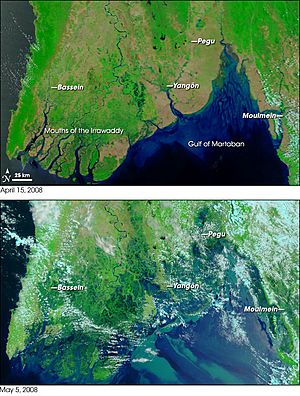
Given high coastal population density, estimates of the number of people at risk of coastal flooding from climate-driven sea level rise varies from 190 million, to 300 million or even 640 million in a worst-case scenario related to the instability of the Antarctic ice sheet. The most people affected are in the densely-populated and low-lying megadeltas of Asia and Africa.
Small islands developing states are especially vulnerable. They are expected to experience more intense storm surges, salt water intrusion, and coastal destruction. Low-lying small islands in the Pacific, Indian, and Caribbean regions are at risk of permanent inundation and population displacement. On the islands of Fiji, Tonga and western Samoa, concentrations of migrants from outer islands inhabit low and unsafe areas along the coasts. Small atoll nations such as Kiribati, Maldives, the Marshall Islands, and Tuvalu are at risk of entire population displacement. A loss of these island could lead to issues of statelessness. Vulnerability is increased by small size, isolation from other land, low financial resources, and lack of protective infrastructure.
Impacts on societies
Climate change impacts health, the availability of drinking water and food, inequality and economic growth. The effects of climate change are often interlinked and can exacerbate each other as well as existing vulnerabilities. Some areas may become too hot for humans to live in. People in some areas may be displaced within their countries or to other countries due to climate-related changes or disasters.
The effects of climate change, in combination with the sustained increases in greenhouse gas emissions, have led some scientists to call it a "climate emergency" or "climate crisis". Some climate researchers and activists have called it an "existential threat to civilization". Some define these threats under the field of climate security. The consequences of climate change, and the failure to address it, can draw focus and resources from tackling its root causes, leading to what researchers have termed a "climate doom loop".
Displacement and migration
Climate change affects displacement of people in several ways. Firstly, involuntary displacement may increase due to more frequent and severe weather-related disasters, which destroy homes and habitats. Effects of climate change such as desertification and rising sea levels gradually erode livelihood and force communities to abandon traditional homelands. Other forms of migration are adaptive and voluntary, based on individual or household decisions. On the other hand, some households may fall (further) into poverty due to climate change, limiting their ability to move to areas less affected.
Migration due to climate and weather is usually national, but long-distance. Slow-onset disasters such as droughts and heat are more likely to induce long-term migration than weather disasters like floods. Migration due to desertification and reduced soil fertility is likely to be predominantly from rural areas in developing countries to towns and cities.
According to the Internal Displacement Monitoring Centre, in 2020 approximately 30 million people were displaced by extreme weather events. In the same year, approximately 10 million were displaced by violence and wars; there may have been a contribution of climate change to these conflicts. In 2018, the World Bank estimated that climate change will cause internal migration of between 31 and 143 million people by 2050, as they escape crop failures, water scarcity, and sea level rise. The study only included Sub-Saharan Africa, South Asia, and Latin America.
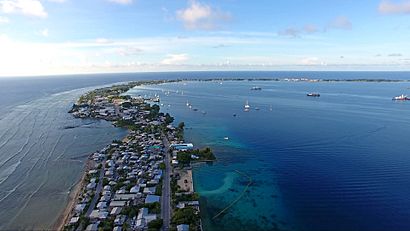
Conflict
Climate change can worsen water conflicts and tensions over other limited resources. Climate change also has the potential to cause large population dislocations and migration, which can also lead to increased tensions. However, factors other than climate change were judged to be substantially more important in affecting conflict over the last century. These factors include intergroup inequality and low socio-economic development. In some cases, climate change can even lead to more peaceful relationships between groups, as environmental problems require common policy to be developed.
Global warming has been described as a "threat multiplier". Conditions in certain places make it more likely that climate change impacts conflict: ethnic exclusion, an economy dependent on agriculture, insufficient infrastructure, poor local governance, and low levels of development. A spike in wheat prices following crop losses from a period of drought may have contributed to the onset of the "Arab Spring" protests and revolutions in 2010.
Economic impacts

Economic forecasts of the impact of global warming vary considerably, but are worse if there is only limited adaptation. Economic modelling may underrate the impact of potentially catastrophic climatic changes. When estimating losses, economists choose a discount rate which determines how much one prefers to have a good or cash now compared to at a future date. Choosing a high discount rate may understate economic losses, as losses for future generations weigh less heavily.
Total economic impacts increase for higher temperature rise. For instance, total damages are estimated to be 90% less if global warming is limited to 1.5 °C (2.7 °F) compared to 3.66 °C (6.59 °F), a warming level chosen to represent no mitigation. One study found a 3.5% reduction in global GDP by the end of the century if warming is limited to 3 °C (5.4 °F), excluding the potential effect of tipping points. Another study noted that global economic impact is underestimated by a factor of two to eight when tipping points are excluded from consideration. In a study on a high-emission scenario, a temperature rise of 2 °C (3.6 °F) by 2050 would reduce global GDP by 2.5%–7.5%. By 2100 in this scenario the temperature would rise by 4 °C (7.2 °F), which could reduce the global GDP by 30% in the worst case.
Global losses reveal rapidly rising costs due to extreme weather events since the 1970s. Socio-economic factors have contributed to the observed trend of global losses, such as population growth and increased wealth. Part of the growth is also related to regional climatic factors, such as changes in precipitation and flooding events. It is difficult to quantify the relative impact of socio-economic factors and climate change on the observed trend. The trend does, however, suggest increasing vulnerability of social systems to climate change.
Economic inequality
Climate change has contributed towards global economic inequality. Wealthy countries in colder regions have either felt little overall economic impact from climate change, or possibly benefited, whereas poor hotter countries very likely grew less than if global warming had not occurred.
Highly affected sectors
Economic sectors directly affected by weather are more impacted by climate change than other sectors. For instance, the agriculture, fisheries and forestry sectors are all heavily affected, but also the tourism and energy sectors. Agriculture and forestry have suffered economic losses due to droughts and extreme heat, for instance in Europe. If global warming surpasses 1.5 degrees, there may be limits to adaptation for existing tourism and for outdoor work.
In the energy sector, thermal power plants depend on water to cool them. Climate change can increase the likelihood of drought and fresh water shortages. In addition, higher operating temperatures reduces their efficiency and hence their output. Hydropower is affected by changes in the water cycle such as river flows. The result of diminished river flow can be a power shortage in areas that depend heavily on hydroelectric power. Brazil in particular, is vulnerable due to its reliance on hydroelectricity, as rising temperatures, lower water flow, and alterations in rainfall, could reduce total energy production by 7% annually by the end of the century. Oil and natural gas infrastructure is affected by climate change and the increased risk of disasters such as storms, cyclones, flooding and rising sea levels.
The insurance and financial services sectors are impacted by global warming. Insurance is an important tool to manage risks, but often unavailable to poorer households. Due to climate change, premiums are going up for certain types of insurance, such as flood insurance. Poor adaptation to climate change further widens the gap between what people can afford and the costs of insurance, as risks increase. In 2019, Munich Re noted that climate change could cause home insurance to become unaffordable for households at or below average incomes.
Social impacts on vulnerable groups
Climate change does not impact people within communities in the same way. Vulnerable groups such as women, the elderly, religious minorities and refugees may be more impacted by climate change than others.
- People living in poverty: Climate change disproportionally affects poor people in low-income communities and developing countries around the world. Those in poverty have a higher chance of experiencing the ill-effects of climate change, due to their increased exposure and vulnerability. A 2020 World Bank paper estimated that between 32 million to 132 million additional people will be pushed into extreme poverty by 2030 due to climate change.
- Women: Climate change increases gender inequality, reduces women's ability to be financially independent, and has an overall negative impact on the social and political rights of women, especially in economies that are heavily based on agriculture.
- Indigenous peoples: Indigenous communities tend to rely more on the environment for food and other necessities, which makes them more vulnerable to disturbances in ecosystems. Indigenous communities across the globe generally have economic disadvantages that are not as prevalent in non-indigenous communities, due to the oppression they have experienced. These disadvantages include less access to education and jobs and higher rates of poverty, which add to their vulnerability to climate change.
- Children: The Lancet review on health and climate change lists children among the worst-affected by global warming. Children are 14–44 percent more likely to die from environmental factors.
See also
 In Spanish: Efectos del calentamiento global para niños
In Spanish: Efectos del calentamiento global para niños
- Anthropocene
- Global catastrophic risk
- Politics of climate change


